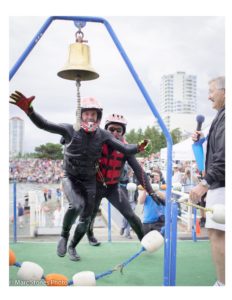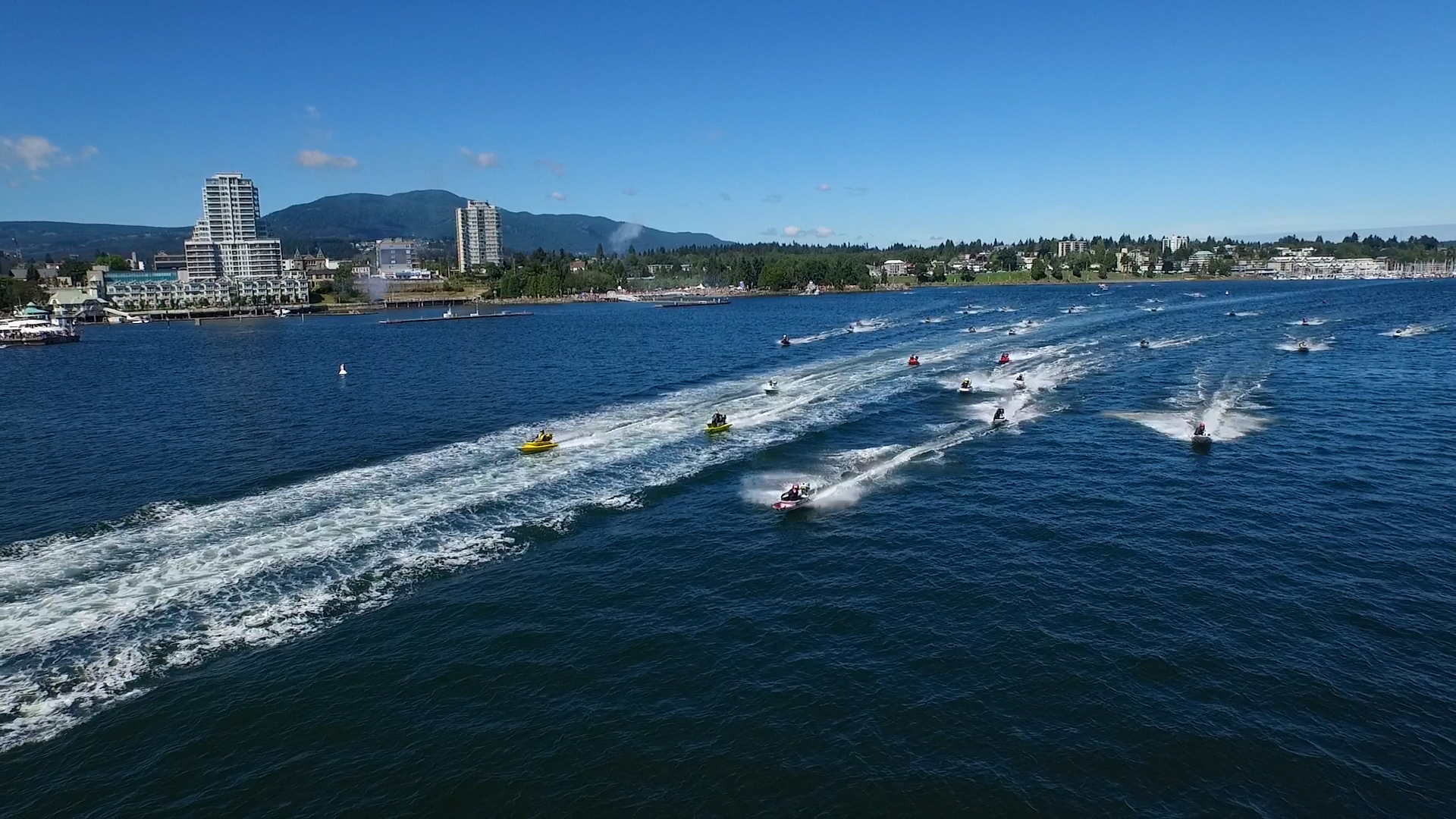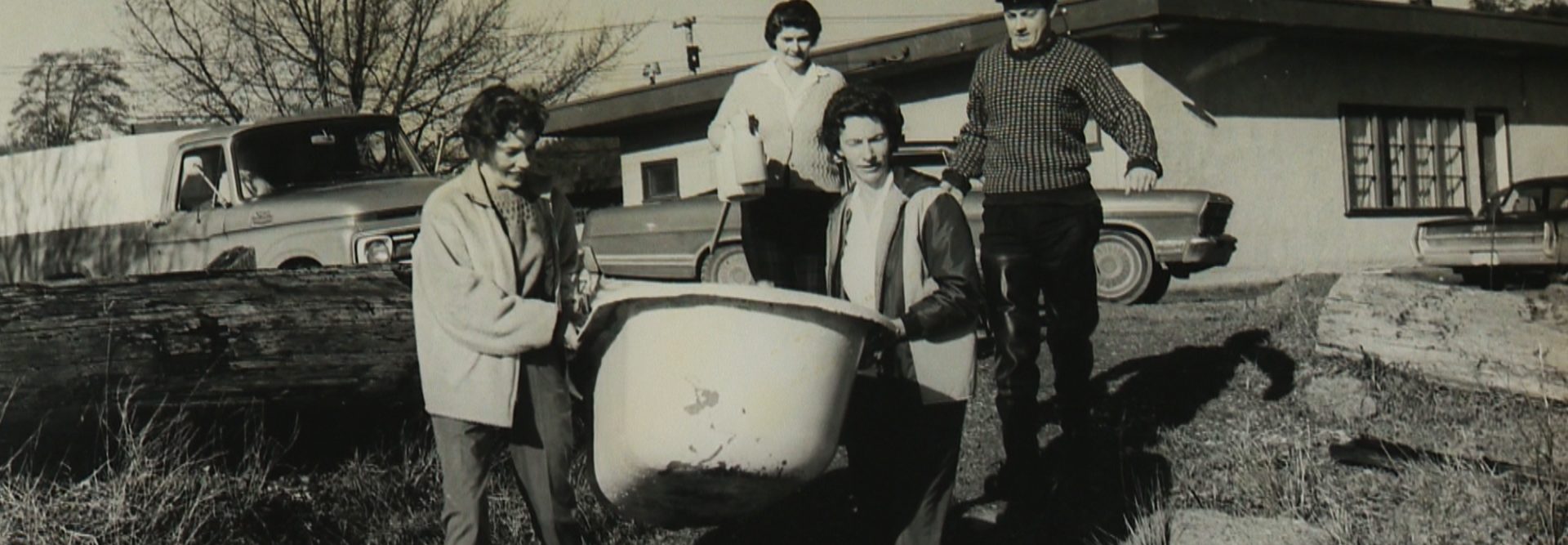Until 1967 when two entrepreneurs got together and dreamed up an event that would put Nanaimo on the map, everyone thought bathtubs were only for washing in. Realtors Glen Galloway and Frank Ney, mayor at the time, were brainstorming an event to celebrate Canada’s centennial when Galloway came up with the wacky idea. But could bathtubs actually float? Intrigued, Ney put up $500 for Galloway to prove they could. It was money well spent.
After all, why splash yourself with hot soapy water in a stationery tub when you can set that tub afloat in a cranky sea, attach a small engine and then take a bath for 58 teeth-jarring kilometres? A surprising number of people from Nanaimo and even from around the world now think that’s what tubs are for. “It’s awesome,” one dripping competitor beams in one of many YouTube videos on the bathtub race, “once you get past the scary parts.”
“It’s a Nanaimo thing,” states another exhausted winner, whose tub is routinely in the rankings. “It’s straight up endurance.”
Imagine 212 tubs setting out from Nanaimo Harbour on that first race on July 30 with around 800 escort and observation boats milling about the starting point. Up to 80 tubs, previously untried, never even got out of the harbour. The first one capsized 30 seconds into the race. The race was an instant sensation. Ney and Galloway could not have come up with a better plan.

So in 1969, when man first walked on the moon, Nanaimo was already becoming synonymous with bathtub racing. “It’s an iconic event”, says this year’s Commodore, Greg Peacock, who was 2nd Vice Commodore for four years prior. His involvement with the Great Race, however, goes back much further. He raced in 1993, the 32nd out of 57 entrants and the last to cross the finish line on yet another of those rough, windy crossings. “Nobody’s ever gotten killed but many contestants walk with a limp for a while after. I think I still have a bit of a limp. A lot of the time it’s an honour just to finish.”
He’s not kidding. The race is not a bath in the park by any means. In 2017 only five tubs out of 33 sloshed back to the finish line, the last of those arriving back over five hours later. (On a flat calm day it has taken the winner a little over an hour.) In 1989 only five of 58 finished when 10-foot waves and thick fog awaited those who hadn’t already wiped out before Entrance Island. In 1987 it was only 12 out of 69 and in 1981 only 30 out of 124.
John Ruttan, who was Nanaimo’s mayor from 2008 until 2014 and the LNBS’s commodore from 1986 until 1991, ran a safety boat for the race back in 1972 and got hooked. Forty-six years later, he’s still involved. For over 20 years his was the face that panting tubbers saw at the finish line. Now, however, his is the voice you hear announcing the spectacular Quality Foods Festival of Fire at exactly 22:00 on the Saturday before the Great Race, 25 minutes of non-stop fireworks exploding across the harbour. The Great Race now keeps good company: three fun-filled days of entertainment, fairs and madcap events. No longer just the Nanaimo Bathtub Race, it’s the Marine Festival and World Championship Bathtub Race.
Ruttan never competed in this race but he once raced a bathtub in Washington and has some idea of what Peacock means about limping. “You get into a 6-foot bathtub and you fold your legs up and sit in there for two or three hours in pounding seas and then try walking.” I ask whether the race has ever had to be cancelled and the answer is no, although it came close in 1987. “We delayed the race for half an hour, hoping the wind would subside and it didn’t. It was my decision to go.”

Rattan recalls those early days: “It started off as a tongue-in-cheek one-off event. Many of the entries never intended to cross the Strait. There was one from the Pacific Biological Station here that had eight working toilets on a raft on oars. They called it the Strait Flush. Well they never got out of the harbour. There were a lot of metal tubs too. When they got water in them they just shot to the bottom, went down like stones.”
I wonder how he feels about the changes in the tubs now.
“It’s s natural evolution of competitive sports no matter how much fun they are. You want to have a faster boat and the latest technology. Sometimes the tubs are getting so fast that some of them can’t find escort boats that can keep up with them. In the early days it was just take a motor out of a box, put it on a metal or plastic tub and then you raced. That was it.”

“Originally there was simply that one stock category,” Peacock adds. “You couldn’t make any modifications to it. Stock embodies the spirit of the race. You hang your engine off the back of the bathtub and you go. But now a lot of people take it more seriously. They have a motor specifically for bathtub racing, they participate in a number of the sanctioned circuit races and they want speed.”
Now in its 52nd year, the race continues to challenge and entertain, constantly evolving. In the 1970s a large brass ship’s bell was added to the finish line and tubbers now had to totter out of their craft on rubbery legs and ring it. Australians had gotten wind of this zany race and started some tub races of their own; there was even a grand prize of a trip to Nanaimo for the winners to compete in the Great Race one year. The following year they began arriving with their modified, high tech and sleek entries, upping the ante for the ‘build your own bathtub in the backyard’ entries. “The Australians certainly brought a new level of competitiveness and technology to the race,” agrees Peacock. “It didn’t take long for the local guys to jump on board with that because they don’t like getting beaten.” (They sure don’t. Nanaimo tubbers have won the event 46 times.)

In 1971, The World’s Largest Bathtub, The Spirit of Nanaimo, appeared on the saline scene. Custom built for the LNBS, the 26-foot promotional bathtub-shaped boat featured regularly in the circuit races, parades, and festivities as well as in the event itself, proudly piloted by Ney, who was then dubbed the Admiral of the Fleet. In 1987, Ney got an even bigger ‘bathtub’ when the 34-foot Spirit of Nanaimo II floated on the scene.
And it was also 1971 when the Hawaiian entry driven by George Kennedy came in last place (#97). His tub had capsized several times and the disgusted Kennedy abandoned it to swim across the finish line.
In 1991 Galloway died. A new modified category had been added to reflect the innovations and its trophy was dedicated in his honour. In 2006 a third category, Super Modified, was added to eliminate the controversy of racers making illegal engine modifications. Other changes included the size of the engines, which climbed from the initial six horsepower to 9.9.
Elaine Nelson-Hosak, owner operator and General Manager of Nanaimo’s hopping Carlos O’Bryan’s Neighbourhood Pub, along with her husband Tom Hosak, was the ‘First Lady’ to ring the bell in 2005, and two years later, racing her modified tub, she placed seventh overall and third in modified, one of 19 entries who completed the trip in rough conditions. Her face lights up as she recalls it:
“It’s one of the most amazing experiences for both the tubber and the spectator. I decided to race for a couple of reasons: it’s the biggest event in Nanaimo and also I noticed there were not a lot of females in the bathtub race so I was up for the challenge. Now my son-in-law, Drew McDonald, is racing. He started in 2015, representing Carlos O’Bryans and Stones Marina, racing in stock category under my retired tub number 505.”
According to Kevin Saunders, who first raced in 2006 at 14 and who has recently written 50 Years of Bathtub Racing 1967-2016, in the early days the rules were simple: the entry had to be made of, or in the shape of, a bathtub; it had to be escorted by another boat, and it had to have a six-horsepower or less engine. (It goes without saying that now tubbers need a boating license.) Competitors have ranged in age from 14 to 87. That first year saw the race start in Nanaimo Harbour, tear across the Strait of Georgia, and finish in Fisherman’s Bay in West Vancouver. Then the finishing line was moved to Vancouver’s Kitsilano Beach. In 1981 a new rule banned tubbers riding in the wakes of their escort boats, which upped the ante and the jarring considerably. In 1997 there was a big change with the race no longer crossing the Strait of Georgia but leaving from Nanaimo Harbour and returning to Departure Bay. Now spectators could enjoy the whole Zen from start to finish, cheering the competitors off and welcoming them back again.
Saunders remembers that first race: “I found a used racing bathtub for sale and fixed it up and I took part in some of the circuit races before the Great Race so that I could practice. It was an extremely rough race, with only 21 of 49 entrants finishing. I held on for the ride and finished in last place after over fout hours at sea. It felt like a huge accomplishment, and I was awarded the trophy for youngest racer to finish that year. I’ve been in the race five times since. In 2013 I won the modified class championship in the Great Race, and in 2016 my brother won the stock class.” He continues to be a familiar face in the races, now volunteering as a director on the board of the LNBS.
In 2015 the finish line moved from Departure Bay to Maffeo-Sutton Park in downtown Nanaimo, a perfect spacious venue that could accommodate most of the other festival activities. Ney, who died in 1992 and whose statue overlooks the action in the park since 1994, would love it.

The distance travelled in the race has never changed but the challenges have. While crossing the strait was often grueling, now that the route goes around Entrance Island, northwest to Winchelsea Island, around a naval ship, past Schooner Cove and back to the harbour, there are different hurdles, Peacock points out. “Now in some ways the course is a little more challenging because you are going in two to three different directions whereas when it went to Vancouver you were going straight across.”
The commodore concludes: “We really encourage boaters to come and visit us and participate in all the festivities. We have the docks and mooring buoys at Newcastle Island. There’s also the boat basin and the local marinas here help to free up spaces for the weekend so we can accommodate visiting boaters. The spirit and intent of the event is to just come out and have some fun.”
Speaking of fun, in 1968 a peculiar vessel crossed in record time. The entry, two bathtubs with a bicycle in the middle and a paddlewheel, arrived at the finish line 36 hours later. By then it and the crew had been reported missing. I wonder if it still holds the record of the longest ever crossing?
The 2018 Marine Festival and World Championship Bathtub Race will be held July 20, 21 and 22 in Nanaimo.
More Info
Website bathtubbing.ca.
Weekend Party While the Great Race is still the huge attraction, the three-day Marine Festival features concerts and events for everyone including a wakeboard competition, a sail-past-on-wheels parade where spectators get to view the tub entries, a beer garden, and the famous (infamous) mayor’s paddlewheel bathtub challenge.
Kevin Saunders book, 50 Years of Bathtub Racing, is available through bathtubbing.com for $25. Click on Marketplace where books and memorabilia are located, or follow this link.
Need a Tub? Contact Tim Charles at platinummarine.ca. He has been working with tub racing champ, Nathan Barlow, manufacturing a prototype from a hull mold Barlow had at home. “It was used by Bryon Whitely in his three big wins and will go on to be the first hull used to develop four stroke tubs. It may change the direction of bathtub racing,” says Barlow. Cost is $6,500 for the whole package, including the 9.9 four stroke Yamaha and it’s being sold at cost because as Charles says: “we want to help everyone get back into tubbing.”
The World Cup Bathtub Racing Series In 1980 the World Cup Bathtub Series was instigated with The Nanaimo News World Cup awarded to the overall champion of a racing circuit sanctioned by the LNBS. Races are now held in Victoria, Sproat Lake, Vancouver, the Okanagan, and Bremerton, Washington.
